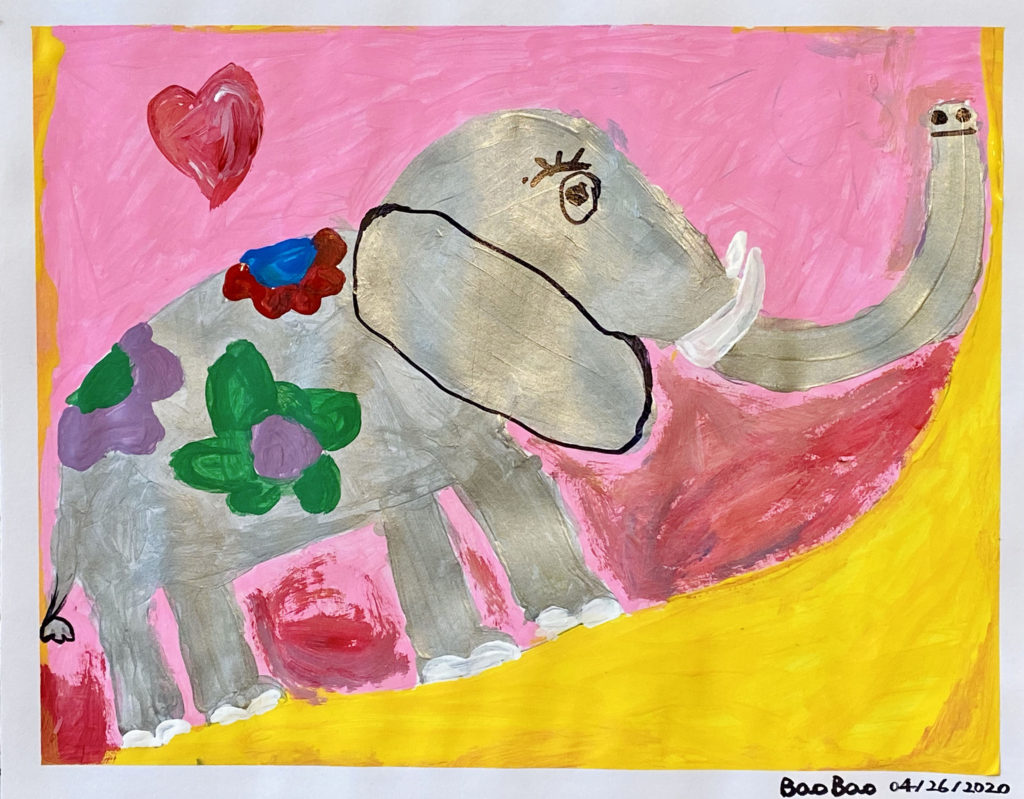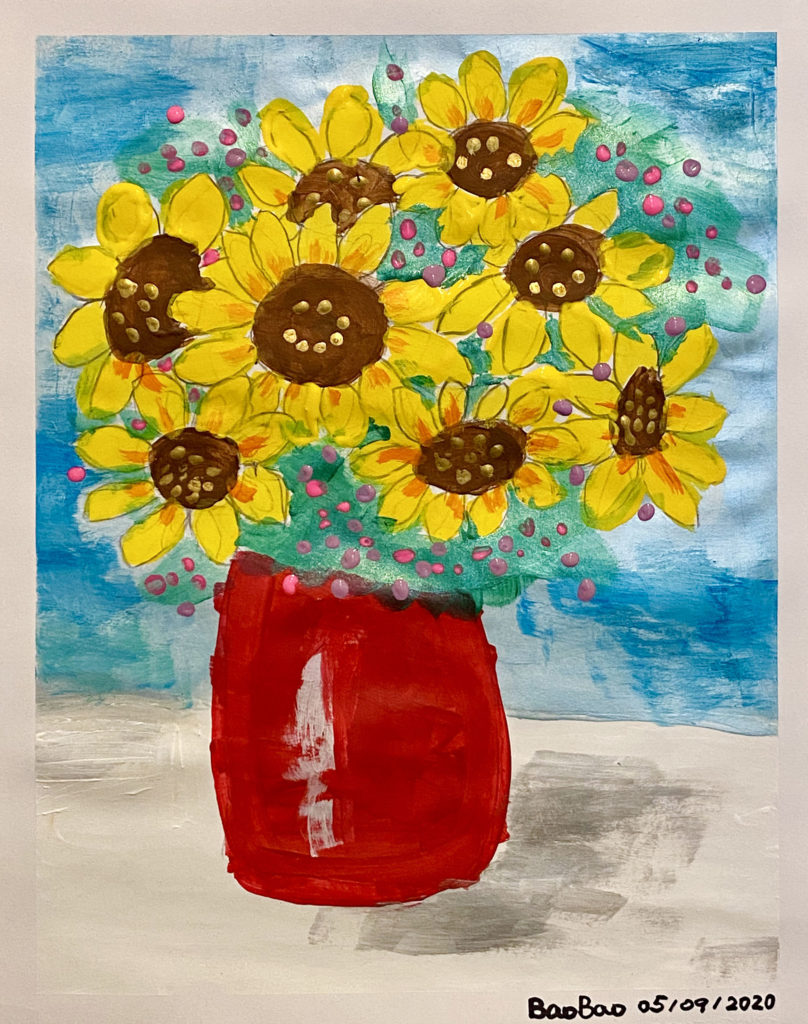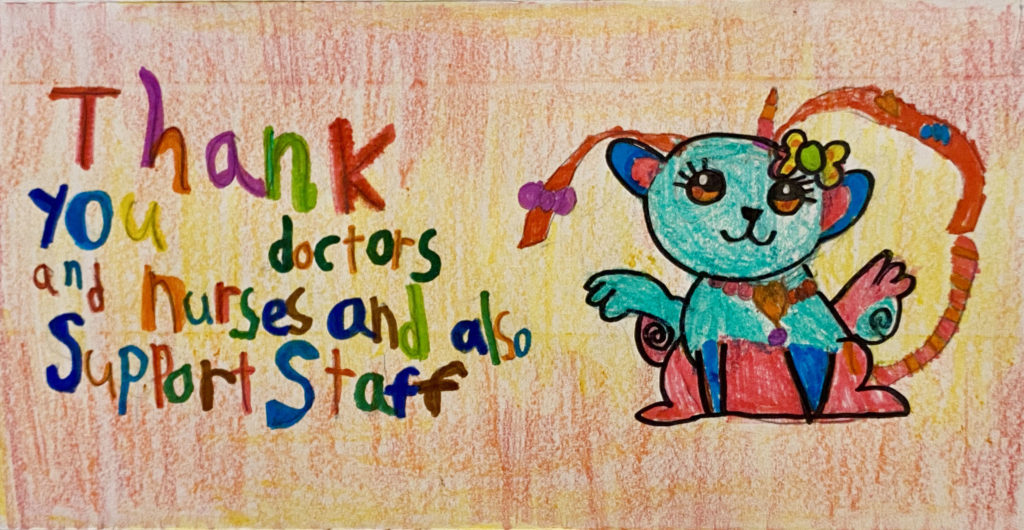
Painting by BaoBao
YOU HAVE BEEN STAYING AT HOME with your two children for weeks. The first conversation you have with your two-year-old each day goes:
~What do you want for breakfast?
~I want [a] party.
~Uh… I am afraid it won’t happen for a while. What can I cook for you?
~I want coffee.
For weeks, post-breakfast mornings are as follows:
Monday, the benchmark price for crude oil in the United States fell to negative $37.631… Mom, I peed in my pants! Deaths in New York and New Jersey hit one-day highs again, but leaders see the coronavirus curve flattening2… Mom, does 25 minus 19 equal 5? People not born in this country find it more and more difficult to apply for temporary working visas, because the president wants “to protect the jobs of our GREAT American Citizens”3… Help me! My butt burps!! The five-year-old daughter of two Detroit first responders has died of complications from coronavirus4… Teacher (via voice message): Today, we will have a busy day: we will do adaptive math and language art; the essential is music with Mr. J. The true number of deaths from COVID-19 in England and Wales is 41% higher than has been previously reported by the government5… Mama, listen to me: Let it go, let it go—
Be prepared: your time will suddenly be broken into pieces. Babysitting here and there. Writing here and there. Cleaning here and there. News-checking here and there. There is endless cooking, laundry, explaining, and hand washing. Before you are exhausted, fire up another Frozen6 marathon and sing with your children as your manuscripts, research proposals, and grant applications are all at once sinking “into the unknown.”
Between potty training and falling baby teeth, you are overwhelmed by messages that are often contradictory: every time you WeChat (the Chinese equivalent of WhatsApp) with your mother in China, she begs you to wear a face mask and gloves whenever you go out for groceries; while your kind-hearted Caucasian colleagues warn you about the danger of wearing a face mask because you will easily become a target of xenophobia. Don’t you know [about the] crazy guy in Rego Park [who] yelled at an Asian woman, ‘You’re the one who brought the virus here!’ 7
One afternoon, your two-year-old completes a 36-piece puzzle all on her own for the first time. You give her a high-five and snap a photo to commemorate the occasion. Your neighbor suddenly text messages to thank you for bringing them the 14 oz canned tomato sauce, “…this is a singular, surreal, and sobering time, not seen in the U.S. since 1918, when my grandmother passed away in her thirties and my father was 18 months old.” The next day, you notice an American flag hanging on your neighbor’s front door.
You wish there was someone to fix the puzzle of the world, or at least, to put the pieces of your broken “normal” life together.
Take a deep breath and wash your hands for twenty seconds. What you need is a tablet and a selection of free children’s eBooks. You click the one titled New York City and read to your children:
New York City is the most densely populated city in the U.S. Every day, you find crowds at the Grand Central Station, in the Metropolitan Museum of Art, and on 42nd Street Broadway…
You feel like teaching history instead of elementary geography. When the new issue of The New Yorker arrives at your door, you find the cover features an illustration of an empty Grand Central Station: at 10:30am, there is only one person in the entire building—a cleaning staff who is sweeping a footprint-free floor.8 You are now in an Edward Hopper painting.9 But even worse, you do not have the option of sitting in a cinema, going to a diner, or reserving a hotel room. Please slowly digest your feelings of aguish and loneliness while sheltering-at-home.
Just when you think you have a five-minute “bathroom break” to check on Facebook posts, your two-year-old barges in and points at your phone. What is this? An ecosphere in the American Museum of Natural History,10 you answer. Can you believe it was sealed twenty years ago and has not been opened since? Do you know what happened? The algae, shrimps, and microbes use sunlight to make a sustainable and balanced habitat. That’s amazing! Your child seems to be happy with this mini science lesson. The toilet flushes. You begin to worry about your favorite cultural institutions such as the MoMA, New York Public Library, and The Met. You wish they were protected in ecospheres that could sustain their huge habitats until their doors opened again.
Several days during the week, there are good hours when your quarantine (and childcare) comrade is on Zoom meetings and your child refuses to take a nap. You figure out ways to turn those empty hours (and an empty self) into something “productive”: teaching your child to paint.
Of course, your child does not have the patience to color within lines. You strike a deal of doing painting lessons for ice cream cones (for yourself) or more screen time (for the children).
Don’t worry about the paint. You can still grab acrylic ones from the local arts-and-crafts store before they permanently close their door. You can place the paint on disposable paper plates that you stored away in the drawer—forgetting for a minute about your sustainable environment phase. Your old paintbrushes are still good, although the tips are as stiff as your lack-of-exercise lower back. You forget when the last time you painted was: you are too used to typing.
Things may not go as you (or your child) wish. Your daughter is well-equipped with the ability of turning a rainbow-colored unicorn into a sweater-wearing donkey. But her choice of using zebra stripes to color tree trunks gives the final product a whimsical and sophisticated taste. Your child refuses light blue or icy white as the background for her snow monkey portrait. Her preference for orange and red reminds you that the impact of global warming has reached every corner of our Mother Earth.
The morning before Mother’s Day, go ahead and discuss with your children what special gift you can prepare for grandma. This makes your five-year-old cry. She says she planted flowers at school, which would have been given to you as a Mother’s Day present. Her voice cracks when she thinks of all the plants that the kids grew, which are probably dead now after the governor shut down schools.
You are stunned. Not only by the misfortune of those plants, but also by the fact that this is the first time your child actually revealed her feelings about the impact of COVID-19 on her life. You are aware of the anxiety that the pandemic could bring to her life now and later,11 but you do not want to give her any public health or political lecture that will make her confused or despaired. You realize you can do something, something positive and distracting. How about we paint Mother’s Day flowers together?

Painting by BaoBao
Your daughter wipes her tears and picks up a paintbrush. She chooses to paint sunflowers and makes the color bright: sky blue wallpaper, a red flower vase, and golden sunflowers all with smiley faces. You and your daughter realize how art heals. The seed of anxiety blooms into the flower of hope. This time, neither of you asked for an ice cream cone or the iPad.
You already forget what life was like during the 2003 SARS outbreak in China. You blame yourself for not keeping anything—no notes or photos—to bring back your personal memories of seventeen years ago: what you ate, what you did, which books you read, what workouts you tried… Two months into the COVID-19 pandemic, you follow a similar daily routine at home. You begin to understand why your memory about SARS was so blurred: if every day is the same, you cannot tell if one day or a hundred days have passed.
The clock hits 8pm. It is time to put your child to bed. You finally have some undisrupted time to read and write. But one news story catches your eye—after reading too many distressing ones, this is rare:
“…as your Pop, the most poignant evidence was seeing your mother give you your first kiss through a P100 mask that smelled faintly of smoke. I’m sorry my boy, but we were warned.”12
It is a letter from Bill Weir, CNN’s chief climate correspondent, to his newborn son, River. He was so frantic about his son being born in the middle of a pandemic, that he was willing to pay $600 for a N95 respirator mask on eBay before he remembered he still had a P100 mask from reporting on the California wild fires a year ago. For Weir, climate change and an unexpected pandemic were not irrelevant news headlines. But he never thought that the two human disasters would be linked together in a labor room by the first kiss of a newborn.
“You were the last thing we imagined on a vacation to Croatia, where your Great Grandpa Frank was born and we found a Dubrovnik lighthouse on Airbnb. …The lighthouse keeper is vigilant and dependable, with a reverence for nature’s power and a commitment to saving lives. This is your destiny, my beautiful River.”
On Sunday morning, you open your laptop. You google an elephant image for your daughter to paint “from life.” She paints a silver elephant standing on a golden land, flowers on its body, and a heart on the pink sky. She calls the painting The Elephant Loves Sunset. Her art teacher shares the painting with the entire school district. It will put smiles on a lot of people as it does for me, he says.
Like Bill Weir, the sophisticated journalist, you feel heartbroken for kids whose Sunday zoo trips have been canceled, their “sea and sky are broken.” But also like Bill Weir, the father of a newborn, your children save you from depression with their giggles, laughter, and loving nature. Your daughter’s art reaches homes well beyond your house: the sunset-loving elephant sends hugs to hospital patients; a winged-kitty applauds for medical staffs; a rainbow peacock lights up the day for the elderly in a neighborhood in California; and smiling sunflowers kiss all moms.
Before you say good night to your five-year-old, the little “lighthouse keeper” tells you it is the happiest day in her life. “Tomorrow will be even happier,” she yells a second later.
You feel secure and cannot be grateful for more. Close your laptop and turn off the light. Congratulations on surviving one more day, with just a few cuts on your fingers when you helped your child with scissors or accidentally grabbed a knife by the blade.
Good night moon. Good night Zoom. I hope you find this guide useful and relax a bit soon. Tomorrow will be another normal day. We are still in the same room.

Painting by BaoBao
Notes
[1] Neil Irwin, “What the Negative Price of Oil Is Telling Us,” The New York Times, April 21, 2020, accessed on May19, 2020., https://www.nytimes.com/2020/04/21/upshot/negative-oil-price.html.
[2]“Bleak Records in N.Y. and N.J., but Leaders See Coronavirus Curve Flattening,” The New York Times, April 8, 2020, accessed on May 19, 2020, https://www.nytimes.com/2020/04/08/nyregion/coronavirus-new-york-update.html.
[3] Betsy Klein, Priscilla Alvarez and Kevin Liptak, “Trump claims he will temporarily suspend immigration into US due to coronavirus fears,” CNN Politics, April 21, 2020, accessed on May 19, 2020, https://www.cnn.com/2020/04/20/politics/donald-trump-immigration-halt-coronavirus/index.html.
[4] Hollie Silverman, “5-year-old daughter of Detroit first responders dies after being diagnosed with coronavirus,” CNN US, April 21, 2020, accessed on May 19, 2020, https://www.cnn.com/2020/04/21/us/detroit-girl-dies-coronavirus/index.html.
[5] Rob Picheta and Simon Cullen, “England’s true Covid-19 death toll 41% higher than previously reported,” CNN World, April 21, 2020, accessed on May 19, 2020, https://edition.cnn.com/world/live-news/coronavirus-pandemic-04-21-20-intl/h_3af702bb5409247b57527a218c47bf9a.
[6] Frozen is a 2013 American animated musical fantasy film produced by Walt Disney Animation Studios. In 2019, Disney released its sequel, Frozen II. “Let It Go” and “Into the Unknown” are among the films theme songs.
[7] “Reports of Anti-Asian Assaults, Harassment and Hate Crimes Rise as Coronavirus Spreads,” Anti-Defamation League (ADL), May 4, 2020, accessed on May 19, 2020, https://www.adl.org/blog/reports-of-anti-asian-assaults-harassment-and-hate-crimes-rise-as-coronavirus-spreads.
[8] Eric Drooker’s illustration, “Grand Central Terminal,” was featured on the March 30, 2020 cover of The New Yorker.
[9] Jonathan Jones, “‘We are all Edward Hopper paintings now’: is he the artist of the coronavirus age?”, The Guardian March 27, 2020, accessed on May 17, 2020, https://www.theguardian.com/artanddesign/2020/mar/27/we-are-all-edward-hopper-paintings-now-artist-coronavirus-age.
[10] On the American Museum of Natural History’s Facebook Page, it published a photo of the ecosphere on April 25, 2020, as part of its virtual exhibitions.
[11] Kate Julian, “What Happened to American Childhood?”, The Atlantic, April 17, 2020, accessed on May 18, 2020, https://www.theatlantic.com/magazine/archive/2020/05/childhood-in-an-anxious-age/609079/.
[12] Bill Weir, “To my son, born in the time of coronavirus and climate change,” CNN Weather, April 25, 2020, accessed on May 19, 2020, https://www.cnn.com/2020/04/25/weather/climate-change-bill-weir-letter-to-son/index.html.
